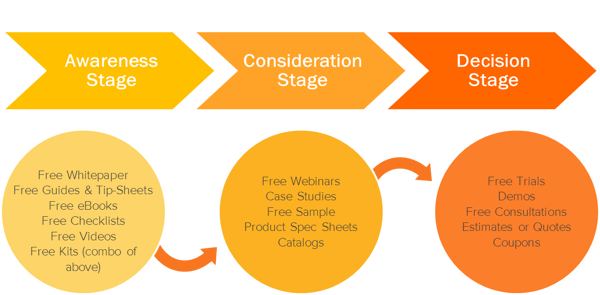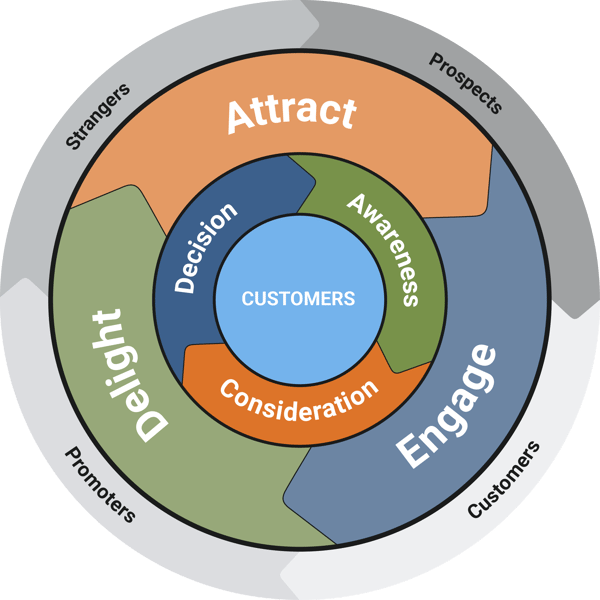
In an online marketplace, your brand needs to stand out. It’s important to communicate a unique brand message through your marketing and sales materials, but nothing generates more demand for your business than the buzz created by your happiest customers.Third party review sites have fast-tracked the decision making process for buyers searching for solutions on the web. Oftentimes, a buying decision is made on the first page of a search engine, meaning many traditional marketing efforts are lost before the person even opens up a webpage.
More than anything, people want to buy from a brand they trust. That’s why gathering customer feedback is an essential part of generating demand for your business.
Demand generation describes all of the actions a business takes to create interest in and desire for their products and/or services at any stage of the buyer’s journey. With targeted efforts from members of your marketing, sales, and customer service teams, investing in a demand generation strategy will (1) create new opportunities for sales (2) nurture qualified prospects towards a sale and (3) help delight your customers and build your brand’s reputation among their peers.
While lead generation refers to the process of converting strangers to leads, demand generation is much more comprehensive. The main difference is that lead generation only targets buyers in the awareness stage of the buyer’s journey, whereas demand generation applies to every stage. 
Typically, a complete demand generation strategy will include activities designed to generate leads, while also supporting those leads as they move through to a sale. The goal is to provide such high quality content and exceptional service that you can easily nurture your customers into brand support and advocacy campaigns to help you generate even more leads.
In addition to giving you a major SEO boost, positive online ratings and reviews tell strangers that your company has a trustworthy solution to the problem they are searching to address. Similarly, a glowing review from a friend or a colleague can convince a new buyer that your company is the absolute best option for meeting their specific needs, educating prospects about your brand and freeing up more time and energy for you to focus on delighting your clients.
Recently, HubSpot has suggested that businesses abandon the traditional “sales funnel” and consider a new model for describing their sales process. The alternative approach is called the Flywheel model and shows a cyclical flow of energy through your process, demonstrating the power your most loyal customers have to build momentum for your business.

The Flywheel actually has a very real basis in physics and may sound familiar in terms of cars or locomotives. Engines have flywheels to keep them turning over as the power generated from one piston leads to the power stroke of the next.
In our case, the flywheel rotates as prospects move through the sales process from lead to prospect to customer, turning faster as you refine your process and more people enter the flywheel. The key is that your happiest customers will become your top promoters, recommending your brand to their peers and facilitating sustainable growth for your business.
According to HubSpot, 81% of buyers trust the recommendations of their families and friends over what the company is telling them. That makes referrals the #1 source of qualified traffic for your business, and it’s a concept that a one-way model like a funnel simply can’t illustrate.
Today’s buyer is more informed than ever. With so much information about other businesses and their offers available with just a few mouse clicks, traditional marketing efforts are becoming less and less effective every day.
“The best way to build customer consensus isn’t to do a better job of connecting individual customer stakeholders to the supplier but to more effectively connect customer stakeholders to one another.” (Harvard Business Review)
As trust in business goes down, trust in the recommendations of friends, family, and colleagues goes up. Your reputation among your customers is the most important factor in whether or not they will buy from you, which is why it’s so important to invest in making sure your online marketing efforts are highly tuned. You must know how to engage with your customers where they are, ask for their feedback, and - most importantly - use that feedback to further refine your processes and make it easier to deliver high value.
That is the power of the flywheel model. When you engage with your buyers at each stage of their journey for solutions to their problems, you are both improving your conversion rates and making the process more enjoyable for your customers, all in a way that encourages positive feedback.
Asking for feedback can be accomplished with one simple question: “How are we doing?” If you’re delighting your customers, they’ll likely give good ratings and reviews willingly, giving you powerful insights for improving your processes and bringing in new customers.
These feedback metrics also help you identify who your top promoters are so you can thank them for their help and keep track of all of your connections, helping you build long-lasting relationships with your various client networks.
In the wake of the COVID-19 pandemic, we have experienced a dramatic shift from in-person to online business activities. While many of us already had a strong online presence before the pandemic, technological hurdles are still being raised for businesses and consumers alike. It’s important to make sure the implementation of your online demand generation strategy is done well so that it aligns with the needs of both your employees and your customers to cut down on any losses in productivity.
The benefit to this online shift is that there are nearly infinite ways to connect with your people wherever they are, as well as much more attainable opportunities for automation. This makes a difference in a world where an immediate response can be the difference between losing a sale and gaining a repeat customer. The better your presence is online and the better you can mirror - or even improve on - your tried-and-true in-person strategies, the easier it is for customers to remain loyal to you and help your businesses grow.
If you'd like to learn more about the ins and outs of demand generation, reach out to our team of marketing experts at Bristol Strategy for a free consultation today. We'd be happy to assist!
Looking to learn more about demand generation? Please download our eBook titled "Guide to Demand Generation Marketing."
Ask us about our unique approach that creates a full-funnel "inbound" engagement model for your business that attracts and converts digitally engaged prospects.